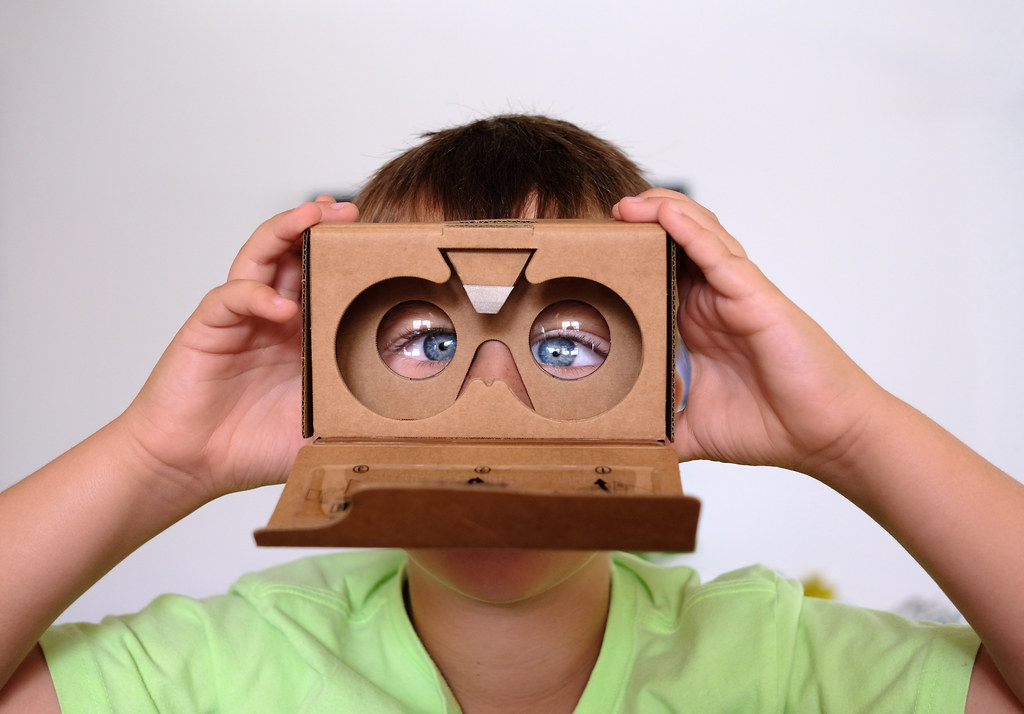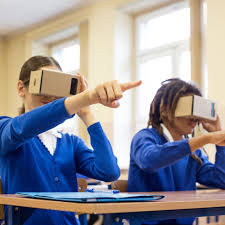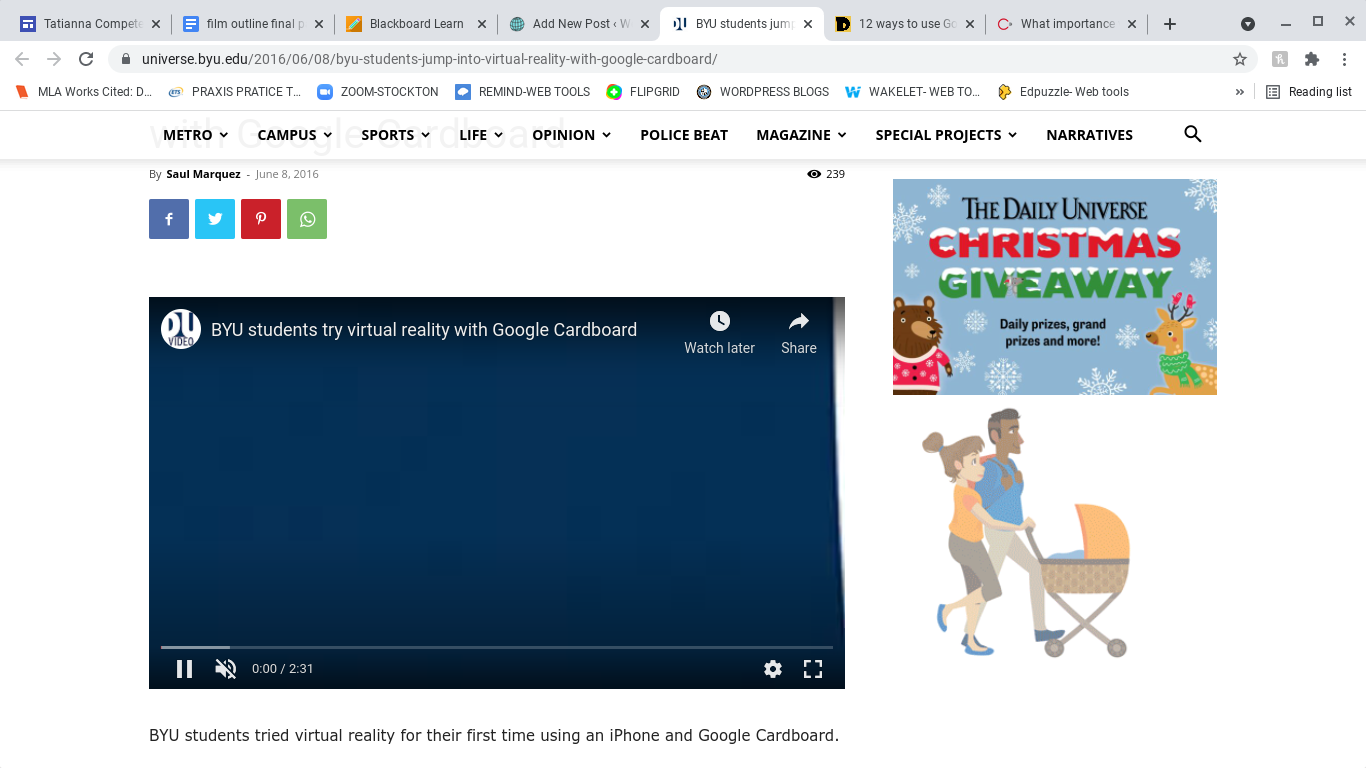Home » Posts tagged 'virtual field trip'
Tag Archives: virtual field trip
Global Collaboration with Google Expeditions
At its heart, Global Collaboration is the act of exploring complex ideas or problems from multiple viewpoints. This is exactly what Google Expeditions, a new virtual reality platform developed by Google, allows students to do. By using a smartphone or computer, as well as Google Cardboard, students can take virtual fieldtrips to a wide range of destinations.
The virtual fieldtrips can take students to explore natural landscapes or on a tour of historical sites such as museums, and ancient buildings. To go even further, teachers can purchase a class kit containing cardboard frames for phones and tablets. These kits allow students to wear a device over their eyes in order to be fully immersed in their exploration. A brief video of how Google Cardboard works and how it can be utilized in class can be viewed below:
As you can see from the video, this technology can be used in incredible ways. For a student like Lance living in the middle of Iowa, the opportunities to visit the big city are very slim. However, with Google Expeditions, along side the use of Google Cardboard, his entire class was able to visit one of the largest cities in the word, Dubai. Being from a small town in Iowa, Lance might have never gotten the opportunity to explore buildings like the Burj Khalifa without this technology. For a student hoping to one day become an architect, this type of experience can be life changing.
In terms of Global Collaboration, I think the opportunities from virtual fieldtrips are extremely obvious. These trips are exceptionally detailed and allow students to explore people and places that they would never have the opportunity to otherwise. Students can now explore anywhere they please. From the architectural masterpieces in Dubai to the depths of the oceans the chances to discover are endless.
Virtual Field Trips with Google Cardboard
Google Cardboard is an affordable virtual reality viewer. The sets are typically made out of cardboard or plastic, keeping them cost-effective and easier to use in classrooms. By sliding a smartphone that has the Google Cardboard app installed into the headset viewer, users can experience a 3D virtual reality at a low cost.

Using Google’s Arts and Culture Expeditions, students can use their Google Cardboard headsets to take virtual field trips to a variety of places. The tool allows you to choose from five different subjects; Science and Technology, Arts, Geography, Natural History, and History. For this post, I’ll be discussing a virtual field trip that is useful for history classes.
There are multiple topics under the history tab from ancient history to Black history. By clicking on the Egypt option, viewers can take a 360-degree tour of the Pyramids at Giza. Each slide gives a brief description of the history.

After touring the pyramids the expedition moves on to teaching about The Great Sphinx. These slides give a history of The Sphinx and some fun facts as well as a 360-degree view of the historic site. Following these slides, a brief overview of the Mastabas, the structures used as tombs for nobles located near The Great Sphinx, is given as well as a tour of them.

Many other important historical locations throughout Egypt are shown in this expedition including the boat pits located at the bottom of the Khufu’s Pyramid, the Causeway, and Cairo.
On the main page for the Egypt expedition, there are even more stories to be found including Myths and Heroes and The Curse of Pharaoh Tutankhamun. Below the stories collection is 8,910 items that students can view to explore Egypt even more in-depth.
These expeditions with Google Cardboard are a great way to give students a new view of history. The tool allows them to step into the location or the time period through virtual reality, giving them a better understanding of the subject. Using Google Cardboard to teach students about the culture and rich history of regions all around the world can be made easy with the use of virtual reality.

Thank you for reading!
Samantha Pollina
Google Cardboard- Blog Post #10
By Tatianna Competello
For our blog post this week we had the choice of picking a learning tool that can be used for virtual reality in classrooms. The tool I decided to talk about is called Google Cardboard. You may be wondering what this app is and how it works. This is an app where you can try virtual reality right from your phone, using Google Cardboard. This virtual reality headset is built from basic cardboard or plastic that brings the viewer in a video or gives them a 360-degree view of an image. It makes the viewer feel like they are actually in that location when in reality they are in the comfort of their own home or classroom. You can view pictures, play games, and experience virtual reality through a VR viewer that you can buy or make at home. This is a great and fun lesson to teach your students especially if you are teaching virtually. I added a video below explaining what exactly Google Cardboard is and how to use it in class. I think this is an interesting video and explains everything you need to know about this app perfectly. You can click here to watch it.
The first step to using this learning tool is to go to your app store and download the app.

When it comes to teaching students of any age reality can always be a challenge. One of the biggest problems being you are not face to face with the students and this can be make learning difficult. I think any app that will allow students to learn something new and be creative is the best lesson a teacher can teach. With Google Cardboard students develop creative skills and be in charge of their own learning. With this app you can teach students how to use virtual reality technology can be used to engage students in topics related to geography, history, or literature by offering a deeply immersive sense of place and time. For example, you can take the students on a virtual field trip and how the students watch the trip the whole time through the google cardboard they created with their phone. I found a very detailed and interesting link that examples several ways how virtual reality with google cardboard can be used together in a classroom. This link truly shows you so many reasons why you should use this app for teaching and learning. You can click here to find it.

Now you may be wondering what are some specific ways the teachers and students can use this in the classroom. To start, you can take the students on virtual field trips. With this, students can choose a place they would like to go to, based on the current area they are in during the class time. The students could all go to the same place if they want or different places, that part does not really matter. The students can look at this location through their google cardboard and then share with the class what they learned from this lesson as well as what this site looked like through the cardboard.

Another way the students can use this app in class is by watching 360- degree videos. There are hundreds of videos the students can watch and on almost any topic the students want to watch the videos on. Such as skydiving, sharks swimming or taking the children on a tour of a museum with history made in it. When it comes to teaching a specific lesson in class you can find a video of the topic you are teaching and have the students watch this video in class.

A very creative way students can use google cardboard in the classroom would be to let the students create their own projects or lesson plans. This can help students can a real idea of how to use this app and all the features that come with it. The best part about this assignment is that the students can make their own 3-D pictures and then share with the class their picture is and why they chose it. This also helps to improve students’ creativity skills. You can click here to see twelve fun ways the students can use this app in the class with specific details for each assignment.
You can watch this video below with students using Google Cardboard for the first time as well as their reactions. I thought this video fit perfectly for this assignment. You can click here to watch it.

The last part of this discussion is to talk about how google cardboard can contribute to a successful global collaboration. According to the website creware.asia it states how “Virtual Reality creates an artificial environment with software. The artificial environment gets presented to the audiences in a way that encourages them to accept and believe it as a real environment. VR technology creates primary experience focusing on two senses, i.e., vision and sound.” One of the best traits that make google cardboard so successful is that students can go on virtual field trips around the world, and be able to see all these places just with their computer at home. The students do not actually have to go to these places physically. When it comes to global collaborations, as a teacher you can have your students interact with other students around the world by going on skype or zoom, and the students could even work on similar assignemts together. A great assignment would be to create a google classroom and then have the students come up with a lesson plan on how to use and create google cardboard and then show other students around the world how to use this, and share that experience together.
Virtual field trip under the sea!
by Shelby Garrison, Garris37

I took a virtual trip under the sea! I saw pictures and videos of coral reefs fish and tons of beautiful parts of sea life! These pictures and videos were under a marina! There were so many coral reefs, of all different shapes and sizes! Tons of unique and colorful fish as well! This trip just makes me want to go scuba diving or snorkeling. I don’t think the pictures do these parts of our world justice. This site had hundreds upon hundreds of photos of our beautiful sea.
A Field Trip to Space
Field trips are a fundamental part of a student’s education. They provide an opportunity for students to learn outside of the classroom. One place I am sure nobody has had the opportunity to take a field trip to, however, is space. Most people would argue the costs and dangers involved in launching a classroom into orbit probably aren’t worth it. However, with Project-Metis, students have the opportunity to explore the solar system like never before.

Project-Metis is a 3-D simulation of our solar system. The simulation provides an accurate location of all the planets in our solar system with educational descriptions of each of them. Based on the time of day, each planet can be seen as it travels across it’s orbit. Using filters and shaders this simulation provides an incredibly detailed representation of what it might actually look like to be in space. This site is perfect for any space enthusiast like myself, offering a wide variety of tools to explore the solar system and all of its mysteries.
Roma: La città di magico eternità
![[Image description: Rome's Trevi Fountain.] Via Unsplash.](https://blogs.stockton.edu/webtools/files/2021/11/photo-1525874684015-58379d421a52.jpeg)
Is there a city in the world more iconic than Rome, Italy? Society was practically built on Rome, which housed an empire that influenced the Western World for centuries to come. For my virtual tour, choosing Italy was a no-brainer, but I didn’t feel like a tourist for immediately leaning toward this iconic tourist city.
I am not going to focus on the Colosseum, because that’s just too touristy. So I started on Capitoline Hill, which was one of Rome’s original 7 hills. It was here that Rome’s first mint was created in The Temple of Juno Moneta (today’s Church of Santa Maria in Aracoeli). The hill became the seat of the city’s government in the year 1,000, which was also where the Senate Building and the Tabularium (Rome’s archives) stood.
Another iconic image in the Eternal City is the Spanish Steps, located in Piazza di Spagna. Thanks to its Baroque architecture that hosts the famous Barcaccia Fountain, tourists throng here every year (except for during COVID in 2020, of course).
The steps go to the Trinita Church, another Baroque marvel commissioned by Pope Innocent XII who had Francesco De Sanctis build it in the 18th century.

Perhaps nothing is more formidable than the Castel Sant’Angelo, the towering papel fortress that towers in the elegant neighborhood of Prati. This mighty structure is the guardian of the Tiber River, towering over its flowing waters for thousands of years. In 123 AD, Emperor Hadrian built the fortress as a tomb for himself and his family, and throughout the ages, it was used as an imperial mausoleum for Roman emperors until the Middle Ages when it became a fortress to protect the city. Despite this iconic stone structure’s many uses, it’s fair to say that no matter what time period it was, it symbolizes Rome’s imperial power and solidifies the city’s place as an iconic world heritage site.
The best part about taking a virtual field trip in such an iconic city is being able to learn about the history behind such imposing monuments. The Capitoline Hill was where such important politics occured throughout the empire’s history, and Castel Sant’Angelo’s 2,000+ existence over the Tiber River is a perfect symbol of the city’s significance.
Rome’s history spans centuries, but what makes it unique is its fascinating combination of ancient paganism and Old World Catholicism everywhere you look. The very cobblestones lining the piazze breathe history, whether it be ancient or from the modern era. It isn’t called the Eternal City for nothing.
Recent Comments